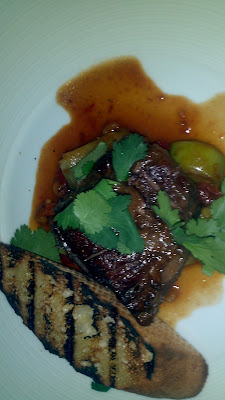 |
| St Paddy's Day beverage of choice |
Tom was tired of me just talking about doing it and went out
on the internet to find the supplies I needed.
Turns out all I needed is a concoction called “pink salt”. All of the remaining ingredients were normal
items you would have in your kitchen anyway.
Tom purchased the inexpensive pink salt at www.sausagemaker.com . It is called Insta-Cure #1 and is available in
8 and 16 ounce bags. This salt has been
dyed pink so you won’t confuse it with regular table salt. It contains sodium nitrite which kills
botulism during the curing process. (I
know some of you may be thinking “Eeek!
Nitrites!” but as I only make corned beef once a year, I am not sweating
it.) You use very little so a small bag
will last you forever.
 |
| Pink Salt |
It turns out that curing your own corned beef is pretty darn
simple. You mix up the brine, place it
with your brisket in a large plastic tub, weight it down with a plate so it
stays submerged, cover it and pop it in your fridge for 5 to 7 days. Even though it sounded simple, we bought a “safety”
corned beef brisket and threw it in the freezer in case mine didn’t turn out.
I checked it every couple of days to make sure it smelled
okay and that the meat was still submerged and it was always just fine. Finally, the big day came when we would see
if we had pulled it off. I had intended
to braise it slowly in the oven but my oven died. (More about that later.) I ended up simmering it in a large roasting
pan over two burners instead. While it was cooking, the whole house had a
wonderful smell of spices and garlic. I
simmered it for a total of four and a half hours until it was fork tender.
 |
| The finished product. |
Finally, it was time to give it a taste. We took it out of the pot, and let it rest
for about 30 minutes, and then Tom cut it into thin slices with the electric
knife. It looked perfect. It had the nice deep pink color that you
expect from corned beef. It looked juicy
but not fatty like some corned beef can be.
Now for the moment of truth: we
each took a taste.
Shut the front door.
It was hands down, the best corned beef I have ever tasted
in my whole life. The depth of flavor
that you get, compared to what you get from a purchased corned beef, is
indescribable. I will never again in my
lifetime buy a corned beef brisket. It was
juicy, spicy, garlicky and just plain delicious. When I think that fear kept me from trying
this sooner I could kick myself. If you
enjoy corned beef, I strongly encourage you to cure your own. The difference is unbelievable.
 |
| Delicious, tender lean corned beef with cabbage, potatoes and carrots. |
Home Cured Corned Beef Brisket with Cabbage
4 to 5 pound beef brisket (get the flat cut; it is leaner)
For the brine:
1 gallon water
1 cup dark brown sugar
8 ounces salt, by weight
4 teaspoons pink curing salt
5 tablespoons pickling
spices1 cup dark brown sugar
8 ounces salt, by weight
4 teaspoons pink curing salt
4 cloves garlic, crushed
For cooking the
beef:
4 cups reduced
sodium or salt free chicken broth
4 cups water1 large onion - roughly chopped
2 carrots - cut in big chunks
2 ribs celery – roughly chopped
2 bay leaves
1 tablespoon black peppercorns
For the
vegetables:
2 or 3 large potatoes,
peeled and quartered
6 carrots, peeled
and cut into large piecesA small head of cabbage, cut into wedges
A week before
cooking the corned beef, heat the brine ingredients in a large stockpot until
salts and sugar have completely dissolved.
Allow to cool completely to room temperature. Place brisket in a large plastic container (I
used a Rubbermaid bin I got at the grocery store) and pour brine over the
meat. Weight down the meat with a bowl
or plate to ensure the beef stays submerged in the brine. Place the container in the fridge and check
it every couple of days to make sure it remains submerged.
The day you cook
the beef, remove it from the brine and discard the brine. Place the broth, water and next 5 ingredients
in a large stockpot or roasting pan and bring to a boil. Add the brisket, return to a boil, and reduce
to a simmer and cover. Simmer until meat
is fork tender, about 50 minutes per pound.
Remove the
brisket to a 13 x 9 baking dish and cover with foil. Allow the beef to rest for 30 minutes before
cutting. Pour the cooking liquid through
a mesh strainer into a Dutch oven and discard the solids.
Add water to the
strained cooking liquid until you have ½ a pot of liquid. Taste for seasoning just in case, but it is
doubtful you will need to add salt. Bring
liquid to a boil. Add carrots and potato
and cook until tender, about 20 minutes.
Remove from liquid and set aside.
Add cabbage and cook until tender, about 25 minutes.
 |
| A must-have for corned beef. |
I serve the beef and
vegetables with my simple mustard sauce.
This is made by combining 1 part hot mustard with 2 parts sour
cream. I use a jar of Coleman’s English Mustard
and 1 cup of light sour cream. It is
creamy with just the right amount of mustard bite.
Now I just have
to get rid of the safety corned beef brisket in my freezer. I think I will smoke it and make pastrami. That’s another experiment I have been
putting off. I hope it turns out as good
as this one.





.jpg)





